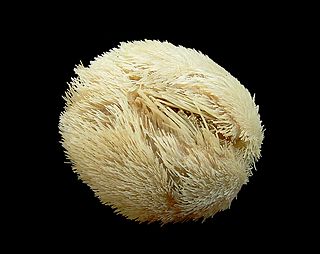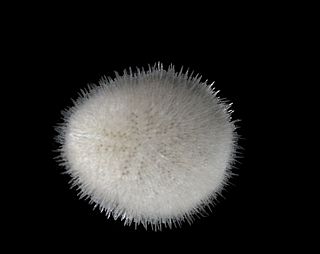
An echinoderm is any member of the phylum Echinodermata. The adults are recognisable by their radial symmetry, and include starfish, brittle stars, sea urchins, sand dollars, and sea cucumbers, as well as the sea lilies or "stone lilies". Adult echinoderms are found on the sea bed at every ocean depth, from the intertidal zone to the abyssal zone. The phylum contains about 7,000 living species, making it the second-largest grouping of deuterostomes, after the chordates. Echinoderms are the largest entirely marine phylum. The first definitive echinoderms appeared near the start of the Cambrian.

The Echiura, or spoon worms, are a small group of marine animals. Once treated as a separate phylum, they are now considered to belong to Annelida. Annelids typically have their bodies divided into segments, but echiurans have secondarily lost their segmentation. The majority of echiurans live in burrows in soft sediment in shallow water, but some live in rock crevices or under boulders, and there are also deep sea forms. More than 230 species have been described. Spoon worms are cylindrical, soft-bodied animals usually possessing a non-retractable proboscis which can be rolled into a scoop-shape to feed. In some species the proboscis is ribbon-like, longer than the trunk and may have a forked tip. Spoon worms vary in size from less than a centimetre in length to more than a metre.

Sea urchins are spiny, globular echinoderms in the class Echinoidea. About 950 species of sea urchin live on the seabed of every ocean and inhabit every depth zone from the intertidal seashore down to 5,000 meters. The spherical, hard shells (tests) of sea urchins are round and covered in spines. Most urchin spines range in length from 3 to 10 cm, with outliers such as the black sea urchin possessing spines as long as 30 cm (12 in). Sea urchins move slowly, crawling with tube feet, and also propel themselves with their spines. Although algae are the primary diet, sea urchins also eat slow-moving (sessile) animals. Predators that eat sea urchins include a wide variety of fish, starfish, crabs, marine mammals, and humans.

Sand dollars are species of flat, burrowing sea urchins belonging to the order Clypeasteroida. Some species within the order, not quite as flat, are known as sea biscuits. Sand dollars can also be called "sand cakes" or "cake urchins".

Sea cucumbers are echinoderms from the class Holothuroidea. They are marine animals with a leathery skin and an elongated body containing a single, branched gonad. Sea cucumbers are found on the sea floor worldwide. The number of holothurian species worldwide is about 1,717, with the greatest number being in the Asia-Pacific region. Many of these are gathered for human consumption and some species are cultivated in aquaculture systems. The harvested product is variously referred to as trepang, namako, bêche-de-mer, or balate. Sea cucumbers serve a useful role in the marine ecosystem as they help recycle nutrients, breaking down detritus and other organic matter, after which bacteria can continue the decomposition process.

The red sea urchin is a sea urchin found in the northeastern Pacific Ocean from Alaska to Baja California. It lives in shallow waters from the low-tide line to greater than 280 m (920 ft) deep, and is typically found on rocky shores sheltered from extreme wave action in areas where kelp is available.

Meoma ventricosa, known by the common names cake urchin and red heart urchin, is a large species of sea urchin which lives in shallow waters in the Caribbean. It may reach a diameter of twenty centimeters and is covered in reddish-brown spines. It has both pentagonal radial symmetry and bilateral symmetry, giving it a sand-dollar appearance; however, two of its five sections are merged more closely than the others.

Dendraster excentricus, also known as the eccentric sand dollar, sea-cake, biscuit-urchin, western sand dollar, or Pacific sand dollar, is a species of sand dollar in the family Dendrasteridae. It is a flattened, burrowing sea urchin found in the north-eastern Pacific Ocean from Alaska to Baja California.

Anodontia alba, or the buttercup lucine, is a species of bivalve mollusc in the family Lucinidae. It can be found along the Atlantic coast of North America, its range extending from North Carolina in the United States to the West Indies.

Ophiura ophiura or the serpent star is a species of brittle star in the order Ophiurida. It is typically found on coastal seabeds around northwestern Europe.

Spatangus purpureus, commonly known as the purple heart urchin, is a species of sea urchin in the family Spatangidae. It is found in the eastern Atlantic Ocean and the Mediterranean Sea, where it lives immersed in the sediment.

Luidia senegalensis, the nine-armed sea star, is a tropical species of starfish in the family Luidiidae found in the western Atlantic Ocean.

Heliophora orbicularis, also known as the West African Sand Dollar, is a small sand dollar in to the family Rotulidae, and the only species in the genus Heliophora. It, and other members of Rotulidae have been found in West African marine strata from the Late Miocene onward. Like the related Rotula, it is still extant.

Irregularia is an extant infraclass of sea urchins that first appeared in the Lower Jurassic.

Ophiocoma echinata, the spiny ophiocoma, is a species of brittle star belonging to the family Ophiocomidae. It is the type species of the genus Ophiocoma and is found in the tropical west Atlantic Ocean, the Caribbean Sea and the Gulf of Mexico.
Saccoglossus bromophenolosus is a species of acorn worm occurring in the northwestern Atlantic Ocean and the northeastern Pacific Ocean. It grows to a length of about 20 cm (8 in) and lives in a burrow in soft sediment in the intertidal and subtidal zones. The scientific name refers to 2,4-dibromophenol, a secondary metabolite present in this worm.

Clypeaster rosaceus, the fat sea biscuit, is a species of sea urchin in the family Clypeasteridae. It occurs in shallow water in the western Atlantic Ocean and was first scientifically described in 1758 by Carl Linnaeus.

Leodia sexiesperforata, commonly known as the six-holed keyhole urchin, is a species of sand dollar, in the echinoderm order Clypeasteroida. It is native to tropical and sub-tropical parts of the western Atlantic Ocean where it buries itself in soft sediment in shallow seas.
Amphiodia urtica, commonly known as the burrowing brittle star or the long arm brittle star, is a species of brittle star belonging to the family Amphiuridae. It is found on the Pacific coast of North America at depths down to about 370 m (1,200 ft).

Echinocyamus pusillus, commonly known as the pea urchin or green urchin, is a species of sand dollar, a sea urchin in the family Fibulariidae, native to the northeastern Atlantic Ocean and the Mediterranean Sea. It buries itself in gravel or coarse sand at depths down to about 1,250 m (4,000 ft).





















